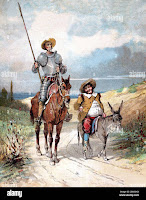Slogans: Tool of Protest
Slogans: Tool of Protest
Likewise “Le Kar rahenge Azadi, Azadi, Azadi…” slogans
have been echoed everywhere, nowadays, in India particularly in Universities, educational
institutions, mass rallies who demonstrate after applying article 370, CAA etc.
After getting freedom and emergency of 1970s’ “Sapurn Kranti” slogan, once
more, the sound covered everyone’s life directly or indirectly. Can it call
Protest against the practitioner of powers? Definitely it is. Let us understand
what is mean of protest.
“Protest is an expression of bearing witness on behalf
of an express cause by words or actions with regard to particular event,
policies or situation” (Wikipedia).
According to the said statement Protest is an
expression against such policies or actions or situation. The policies,
actions, situation are served by power holder institutions such as Religion,
Politics, bureaucrats, Law makers, education etc. People gather together and
demonstrate which one tool of protest is by saying their “strong disagreement,
disapproval or opposition” (Cambridge Dict)
In
every era / period, in Indian perspective, protest has been done. The protest
is also should be resistance to upper class- caste, power holders by lower
class-caste people. The various tools are used by practioners of protest such
as literature, songs, culture, war, language etc. Shri Chhatrapati Shivaji
Maharaj, a great king of India, establish his kingdom by protesting his
cotemporary kinship system.
Mahatma
Jyotiba Phule, Savitribai Phule, Rahshri Shahu Maharaj, Saint Gadge Maharaj,
Karmveer Bhaurao Patil , etc had done social reform in India particularly in
Maharashtra. They have been protested against an evil system in Indian society.
Therefore, the protest has been happened through the various tools in various
institutions.
Likewise,
the social reformation which is done in India, the political reformation is
also done with a great impact of slogan in their movements.
Slogan is a
literary device:
Slogans
are one of the important tools for protest. It makes direct impact on the
psyche of human mind. There is rhetorical function of slogan. Slogans, as a
rhetorical device, have a rich history. They have provided historians with
topical outlines of the major concerns, frustration, and hopes of society.
Slogans
have ‘social symbols’ they have united, divided, and even converted. In so
doing, slogans have become a direct link to social or individual slogan.(Robert
Jr 1.)
Powerful
slogans were become powerful tools for freedom fighters. Indian freedom
fighters wanted to protest against British Rulers. The journey of freedom was
beginning with the uprising of 1857 and India got freedom in 1947. The present
paper will discuss the popular slogans between 1857 to 1947.
Inqilab
Zindabad was most popular
slogan used by Indian freedom fighters. The Meaning of Inqilab Zindabad is
‘Long Live Revolution’. This phrase actually translated meaning of Viva la
revolucion. It was used in Mexican revolution during 1916-1920. It used to
raise consciousness and fighting spirit to fight against British rulers in
India. It was coined by the Urdu poet Maulana Hasrat Mohini, in 1921 and
popularized by Bhagat Singh during the late 1920s. It became the official
slogan of the Hindustan Socialist republican Association (H. S.R.A) as well as
All India Azad Muslim Conference. In 8th April 1929, B.K. Dutta and
Bhagat Singh had shouted this slogan after bombing the Central Legislative
Assemble in Delhi.
Do
or Die. This slogan is
proclaimed by Mahatma Gandhi. On the eve of 8th August 1942
while addressing the congress delegates. The meeting of All India Congress
Committee was held a meeting on 7th august 1942 in Bombay. The prime
movement in India Freedom history is “Quit India”, which is a strongest protest
against the British Ruler. There the resolution was moved by Pt. Jawarlal Nehru
& it was overwhelming with majority. The resolution declared that the
immediate ending of the British rule in India as an urgent necessity. ‘Do or
Die’ means ‘we shall either free India from British rules of die in the attempt
to achieve this goal. It was a strong protest by Indian.
Jaihind: Jaihind originally means ‘Victory to India’. It was
coined by Chempalaraman Pillai, who was a colleague of Subhash Chandra Bose in
1907. This term ‘Jaihind’ became popular as a slogan and greeting of the Indian
National Army which was organized by Subhash Chandra Bose. Later, after the
independence, it emerged as a national slogan and has been a common form of
greeting the people of India by political leaders and prime ministers such as
Jawaharlal Nehru, Indira Gandhi, Rajiv Gandhi, etc. There is strength in that
word to awake the people consciousness against the British ruler.
Purn
Swaraj means “complete
self-rule”. Even it was demand still it played vital role to create the
background for fighting for freedom. Here the first time the protest was done
for entire freedom. It boosted to protest against the British ruler. It is also,
called ‘declaration of the independence of India’. It was promote by Indian
National congress.
Reference:-
1)
https://en.wikipedia.org/wiki/Protest
2)
https://dictionary.cambridge.org/dictionary/english/protest
3) Robert E. Denton Jr.’s Article “The Rhetorical
Functions of Slogans: Classifications and Characterisitcs”.
4)
Chandra, Bipin. “India’s Struggle for Independence:
1857-1947”(2009).

Comments
Post a Comment